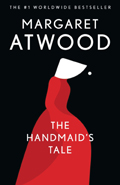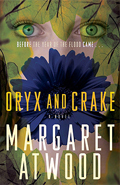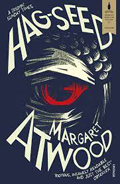This month, Margaret Atwood is due to publish a volume of her non-fiction essays in a hefty volume titled Burning Questions. Atwood has always been interested in questions and has involved herself in many debates – about science, the environment, feminism and gender to name a few. Her collection of thoughts from the last twenty years or so will be worth reading, as the shape and direction of contemporary thinking has shifted so much in the last two decades.
 Many people will know Atwood primarily for her novel The Handmaid’s Tale – or perhaps not even the novel itself but the Hulu series based on it. First published in 1985, it is one of the most important novels of the late 20th century, tackling the rise of the Christian right wing in America and the threats to the freedoms that have been gained by women in society. In her first three novels, The Edible Woman, Surfacing and Lady Oracle, Atwood established herself as a feminist voice in fiction, exploring gender identities. However, she remains open-minded and balanced and it is interesting to see that in The Handmaid’s Tale there is room for criticism of certain aspects of feminist thinking, while its outlook is certainly feminist. The novel won the Arthur C Clarke Award for Science Fiction, but apart from the fact that it is set in the future, it is far from conventional science fiction. Atwood prefers the term ‘speculative fiction’ – using literature to explore the directions in which humankind could progress. And as she has said, of all the atrocities in the society of Gilead in the novel, ‘There’s a precedent in real life for everything in the book. I decided not to put anything in that somebody somewhere hadn’t already done.’ Read this article about the novel, and its sequel, The Testaments, which shared the Booker Prize in 2019.
Many people will know Atwood primarily for her novel The Handmaid’s Tale – or perhaps not even the novel itself but the Hulu series based on it. First published in 1985, it is one of the most important novels of the late 20th century, tackling the rise of the Christian right wing in America and the threats to the freedoms that have been gained by women in society. In her first three novels, The Edible Woman, Surfacing and Lady Oracle, Atwood established herself as a feminist voice in fiction, exploring gender identities. However, she remains open-minded and balanced and it is interesting to see that in The Handmaid’s Tale there is room for criticism of certain aspects of feminist thinking, while its outlook is certainly feminist. The novel won the Arthur C Clarke Award for Science Fiction, but apart from the fact that it is set in the future, it is far from conventional science fiction. Atwood prefers the term ‘speculative fiction’ – using literature to explore the directions in which humankind could progress. And as she has said, of all the atrocities in the society of Gilead in the novel, ‘There’s a precedent in real life for everything in the book. I decided not to put anything in that somebody somewhere hadn’t already done.’ Read this article about the novel, and its sequel, The Testaments, which shared the Booker Prize in 2019.
Read this recent interview with Atwood, where gender identities become a prickly issue, but the final message is one of tolerant, open debate.
Some suggestions for further reading:
 Female perspectives are central to her fiction. The great novel Cat’s Eye (1988) recounts a girl growing up and revolves around a toxic female friendship. The Robber Bride (1993) also deals with complex female relationships which are both developed and betrayed – her female characters are not necessarily good and there are certainly repugnant, manipulative females in these novels.
Female perspectives are central to her fiction. The great novel Cat’s Eye (1988) recounts a girl growing up and revolves around a toxic female friendship. The Robber Bride (1993) also deals with complex female relationships which are both developed and betrayed – her female characters are not necessarily good and there are certainly repugnant, manipulative females in these novels.
 Atwood embraced science fiction more clearly in Oryx and Crake (2003), a dystopian novel where the world has been upended by the commercial pharmaceutical industry and genetic manipulation of the animal kingdom. While the science fiction is clear, with a race of peaceful blue people, the state of the rest of the world is all too believable. That novel became the first of a three books known as the Maddaddam Trilogy, developing the ideas of Oryx and Crake further.
Atwood embraced science fiction more clearly in Oryx and Crake (2003), a dystopian novel where the world has been upended by the commercial pharmaceutical industry and genetic manipulation of the animal kingdom. While the science fiction is clear, with a race of peaceful blue people, the state of the rest of the world is all too believable. That novel became the first of a three books known as the Maddaddam Trilogy, developing the ideas of Oryx and Crake further.
 Quite different is the 2016 novel Hagseed, about a production of Shakespeare’s play The Tempest in a prison, as part of a project to develop prisoners’ skills, humanity and awareness. The process of the theatrical production becomes a version of play itself, with distinct parallels drawn between the two – with dramatic results, in both literal and casual senses of the word.
Quite different is the 2016 novel Hagseed, about a production of Shakespeare’s play The Tempest in a prison, as part of a project to develop prisoners’ skills, humanity and awareness. The process of the theatrical production becomes a version of play itself, with distinct parallels drawn between the two – with dramatic results, in both literal and casual senses of the word.
With numerous collections of poetry, 18 novels to date and a wealth of non-fiction writing, there is plenty in Margaret Atwood’s oeuvre to explore and enjoy. Here is her own website.
And here is a piece about her short story When It Happens.